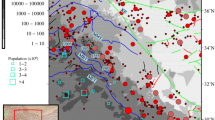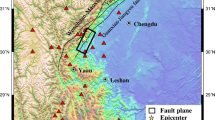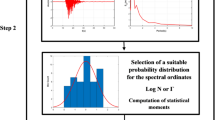Abstract
The strong ground motions for the 2001 Bhuj (M w 7.6) India earthquake have been estimated on hard rock and B/C boundary (NEHRP) levels using a recently modified version of stochastic finite fault modeling based on dynamic corner frequency (Motazedian and Atkinson in Bull Seismol Soc Am 95, 995–1010 2005). Incorporation of dynamic corner frequency removes the limitations of earlier stochastic methods. Simulations were carried out at 13 sites in Gujarat where structural response recorder (SRR) recordings are available. In addition, accelerograms were simulated at the B/C boundary at a large number of points distributed on a grid. The corresponding response spectra have also been estimated. The values of peak ground accelerations and spectral accelerations at three periods (0.4, 0.75 and 1.25 s) are presented in the form of contour maps. The maximum value of peak ground acceleration (PGA) in the center of meizoseismal zone is 550 cm/s2. The response spectral acceleration in same zone is 900 cm/s2 (T = 0.4 s), 600 cm/s2 (T = 0.75 s) and 300 cm/s2 (T = 1.25 s). The innermost PGA contour is on the fault plane. A comparison of the PGA values obtained at 13 sites in this study with those obtained in earlier studies on the same sites, but employing different methods, show that the present PGA values are comparable at most of the sites. The rate of decay of PGA values is fast at short distances as compared to that at longer distances. The PGA values obtained here put some constraints on the expected values from a similar earthquake in the region. A synthetic intensity map has been prepared from the estimated values of PGA using an empirical relation. A comparison with the reported intensity map of the earthquake shows the synthetic MMI values, as expected, are lower by 1 unit compared to reported intensity map. The contour map of PGA along with the contour maps of spectral acceleration at various periods permit the assessment of damage potential to various categories of houses and other structures. Such information will be quite important in planning of mitigation and disaster management programs in the region.







Similar content being viewed by others
References
Aki, K. (1967), Scaling law of seismic spectrum, J. Geophys. Res. 72, 1217–1231.
Anderson, J. and Hough, S. (1984), A model for the shape of the Fourier amplitude spectrum of acceleration at high frequencies, Bull. Seismol. Soc. Am. 74, 1969–1993.
Antolik, M. and Dreger, S. D. (2003), Rupture process of the 26 January 2001 Mw 7.6 Bhuj, India, earthquake from teleseismic broadband data, Bull. Seismol. Soc. Am. 93, 1235–1248.
Atkinson, G. M. and Boore, D. M. (1995), Ground Motion Relations for Eastern North America, Bull. Seismol. Soc. Am. 85, 17–30.
Atkinson, G. M. and Boore, D. M. (2006), Earthquake ground motion prediction equations for Eastern North America, Bull. Seismol. Soc. Am. 96, 2181–2205.
Bendick, R., Bilham, R., Fielding, E., Gaur, V. K., Hough, S. E., Kier, G., Kulkarni, M. N., Martin, S., and Mukul, M. (2001), The 26 January 2001 “Republic Day” earthquake, India, Seismol. Res. Lett. 72, 328–335.
Beresnev, I. A. and Atkinson, G. M. (1997), Modeling finite fault radiation from the ω n spectrum, Bull. Seismol. Soc. Am. 87, 67–84.
Beresnev, I. A. and Atkinson, G. M. (1998), FINSIM: a FORTRAN program for simulating stochastic acceleration time histories from finite faults, Seismol. Res. Lett. 69(1), 27–32.
Beresnev, I. A. and Atkinson, G. M. (1999), Generic finite fault model for ground motion prediction in eastern north America, Bull. Seismol. Soc. Am. 89, 608–625.
Beresnev, I. A. and Atkinson, G. M. (2002), Source parameters of earthquakes in eastern and western north America based on finite fault modeling, Bull. Seismol. Soc. Am. 92, 695–710.
Biswas, S. K. (1987), Regional tectonic framework, structure and evolution of the western marginal basins of India, Tectonophysics 135, 307–327.
Biswas, S. K. (2005), A review of structure and tectonics of Kutch basin, western India, with special reference to earthquake, Current Science 88(10), 1592–1600.
Bodin, P. and Horton, S. (2004), Source parameters and tectonic implications of aftershocks of the Mw7.6 Bhuj earthquake of January 26, 2001, Bull. Seismol. Soc. Am. 94, 818–827.
Bodin, P., Malagnini, L., and Akinci, A. (2004), Ground-Motion Scaling in the Kachchh Basin, India, Deduced from Aftershocks of the 2001 M w 7.6 Bhuj Earthquake, Bull. Seismol. Soc. Am. 94, 1658–1669.
Boore, D. (1983), Stochastic simulation of high-frequency ground motions based on seismological models of the radiated spectra, Bull. Seismol. Soc. Am 73, 1865–1894.
Boore, D. M. and Joyner, W. B. (1997), Site amplifications for generic rock sites, Bull. Seismol. Soc. Am. 87, 327–341.
Brune, J. N. (1970), Tectonic stress and the spectra of seismic shear waves from earthquakes, J. Geophys. Res. 75, 4997–5009.
Brune, J. N. (1971), Seismic sources, fault plane studies and tectonics, EOS 52, 178–187.
Cramer, C. H. and Kumar, A. (2003), 2001 Bhuj, India, earthquake engineering seismoscope recordings and Eastern North America ground-motion attenuation relations, Bull. Seismol. Soc. Am 93, 1390–1394.
Gupta, H. K., Harinarayana, T., Kousalya, M., Mishra, D. C., Mohan, I., Purnachandra Rao, N., Raju, P. S., Rastogi, B. K., Reddy, P. R., and Sarkar, D. (2001), Bhuj earthquake of 26 January 2001, J. Geol. Soc. India 57, 275–278.
Gahalaut, V. K. and Burgmann, R. (2004), Constraints on the Source Parameters of the 26 January 2001 Bhuj, India, Earthquake from Satellite Images, Bull. Seismol. Soc. Am. 94, 2407–2413.
Hanks, T. C. and Mcguire, R. K. (1981), The character of high frequency strong ground motion, Bull. Seismol. Soc. Am. 71, 2071–2095.
Hanks, T. C. (1982), f max , Bull. Seismol. Soc. Am. 72, 1867–1879.
Hough, S. E., Armbruster, J. G., Seeber, L., and Hough, J. F. (2000), On the modified Mercalli intensities and magnitudes of the 1811–1812 New Madrid, central United States earthquakes, J. Geophys. Res. 105, 23,869–23,864.
Hough, S. E., Martin, S., Bilham, R., and Atkinson, G. M. (2002), The 26 January 2001 M 7.6 Bhuj, India, Earthquake: observed and Predicted Ground Motions, Bull. Seismol. Soc. Am. 92, 2061–2079.
Iyengar, R. N. and Raghukanth, S. T. G. (2003), Attenuation of strong ground motion and site specific seismicity in Peninsular India, Proc. of National Seminar on Seismic Design of Nuclear Power Plants, 21–22 February 2003, SERC Chennai, Allied Publ. Pvt. Ltd. N. Delhi, 269–291.
Iyengar, R. N. and Raghukanth, S. T. G. (2006), Strong ground motion estimation during the Kutch, India earthquake, Pure Appl. Geophys. 163, 153–173.
Johnston, A. C. (1996a), Seismic moment assessment of earthquakes in stable continental regions—II: historical seismicity, Geophys. J. Int. 125, 639–678.
Johnston, A. C. (1996b), Seismic moment assessment of earthquakes in stable continental regions—III: New Madrid 1811–1812, Charleston 1886, and Lisbon 1755, Geophys. J. Int. 126, 314–344.
Joyner, W. B. and Boore, D. M. (1986), On simulating large earthquakes by Green’s-function addition of smaller earthquakes, Earthquake Source Mechanics, AGU Monograph 37, 269—274.
Kanamori, H. and Anderson, D. L. (1975), Theoretical basis of some empirical relations in seismology, Bull. Seismol. Soc. Am. 65, 1073–1095.
Mandal, P., Rastogi, B. K., Satyanarayana, H. V. S., Kousalya, M., Vijayraghvan, R., Satyamurthy, C., Raju, I. P., Sarma, A. N. S., and Kumar, N. (2004), Characterization of causative fault system for the 2001 Bhuj earthquake of M w 7.7, Tectonophysics 378, 105–121.
Mandal, P., Chadha, R. K., Raju, I. P., Kumar, N., Satyamurty, C. and Narsaiah, R. (2007), Are the 7 March 2006 Mw 5.6 event and the 3 February 2006 Mw 4.58 event triggered by the five years continued occurrence of aftershocks of the 2001 M w 7.7 Bhuj event?, Curr. Sci. 92, 1114–1124.
Mori, J. (2001), Slip distribution of mainshock, A comprehensive survey of the 26th January 2001 earthquake (M w 7.7) in the state of Gujarat, India, 41–45.
Motazedian D. and Atkinson G. M. (2005), Stochastic finite-fault modeling based on dynamic corner frequency, Bull. Seismol. Soc. Am. 95, 995–1010.
Negishi, H., Mori, J., Sato, T., Singh, R., Kumar, S., and Hirata, N. (2002), Size and orientation of the fault plane for the 2001 Gujarat, India earthquake (M w 7.7) from aftershock observations: a high stress drop event, Geophys. Res. Lett. 29, 1949, doi:10.1029/2002GL015280.
Parvez, I. A., Vaccari, F., and Panza, G. F. (2003), A deterministic seismic hazard map of India and adjacent areas, Geophys. J. Int. 155, 489–508.
Rastogi, B. K. (2001), Ground deformation study of M w 7.7 Bhuj earthquake of 2001, Episode 24(3), 160–165.
Rastogi, B. K. (2004), Damage due to the M w 7.7 Kutch, India earthquake of 2001, Tectonophysics 390, 85–103.
Richter, C. F. (1958), Elementary Seismology, W. H. Freeman, San Francisco, 768 p.
Schweig, E., Gomberg, J., Petersen, M., Ellis, M., Bodin, P., Mayrose, L., and Rastogi, B. K. (2003), The M w 7.7 Bhuj Earthquake: Global lessons for earthquake hazard in intra-plate regions, J. Geol. Soc. India. 61, 277–282.
Silva, W. and Darragh, R. B. (1995), Engineering characterization of strong ground motion recorded at rock sites, Electric Power Research Institute, Palo Alto, Calif., Report No. TR-102262.
Singh, S. K., Bansal, B. K., Bhattacharya, S. N., Pacheco, J. F., Dattatrayam, R. S., Ordaz, M., Suresh, G., Kamal, and Hough, S. E. (2003), Estimation of Ground Motion for Bhuj (26 January 2001; Mw 7.6) and for future Earthquakes in India, Bull. Seismol. Soc. Am. 93, 353–370.
Talwani, P. and Gangopadhyay, A. (2001), Tectonic framework of the Kachchh earthquake of January 26, 2001, Seismol. Res. Lett. 72, 336–345.
Wesnousky, S. G., Seeber, L., Rockwell, T., Thakur, V., Briggs, R., Kumar, S., and Ragona, D. (2001), Eight days in Bhuj: field report bearing on surface rupture and genesis of the 26 January 2001 Republic Day earthquake of India, Seismol. Res. Lett. 72, 514–524.
Yagi, Y. and Kikuchi, M. (2001), Western India earthquake, http://wwweic.eri.utokyo.ac.jp/index-e.html.
Acknowledgments
The authors are grateful to Prof. Dariush Motazedian for providing the EXSIM program. The authors also thank the anonymous reviewers for comments and suggestions that greatly improved the manuscript. DK is grateful to Kurukshetra University, Kurukshetra for support. The study was supported by Ministry of Earth Sciences, Govt. of India.
Author information
Authors and Affiliations
Corresponding author
Rights and permissions
About this article
Cite this article
Chopra, S., Kumar, D. & Rastogi, B.K. Estimation of Strong Ground Motions for 2001 Bhuj (M w 7.6), India Earthquake. Pure Appl. Geophys. 167, 1317–1330 (2010). https://doi.org/10.1007/s00024-010-0132-y
Received:
Revised:
Accepted:
Published:
Issue Date:
DOI: https://doi.org/10.1007/s00024-010-0132-y




